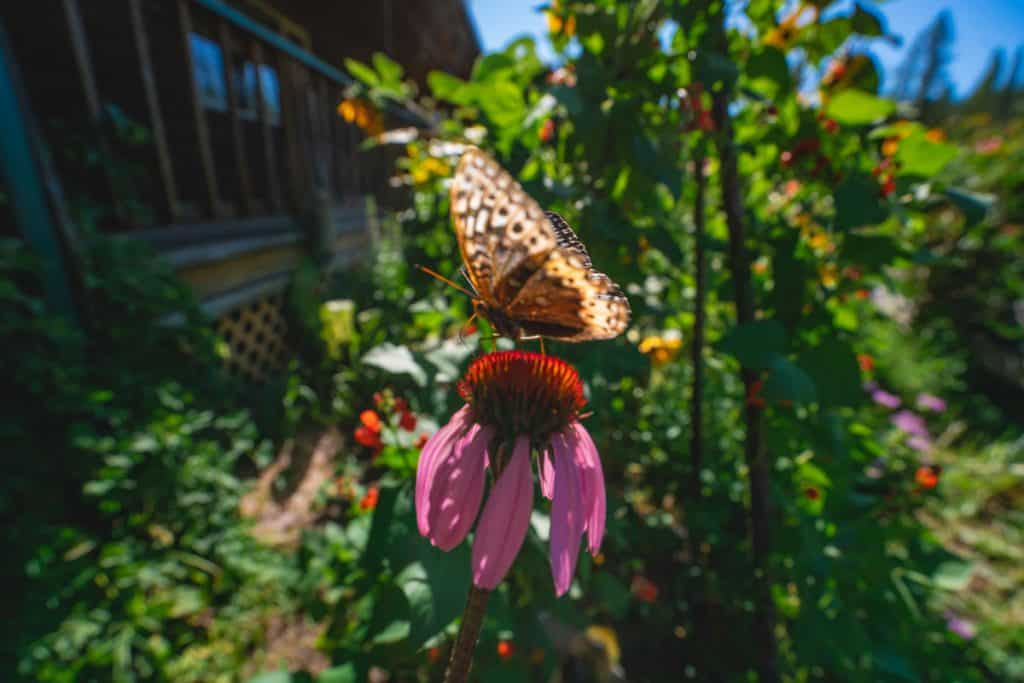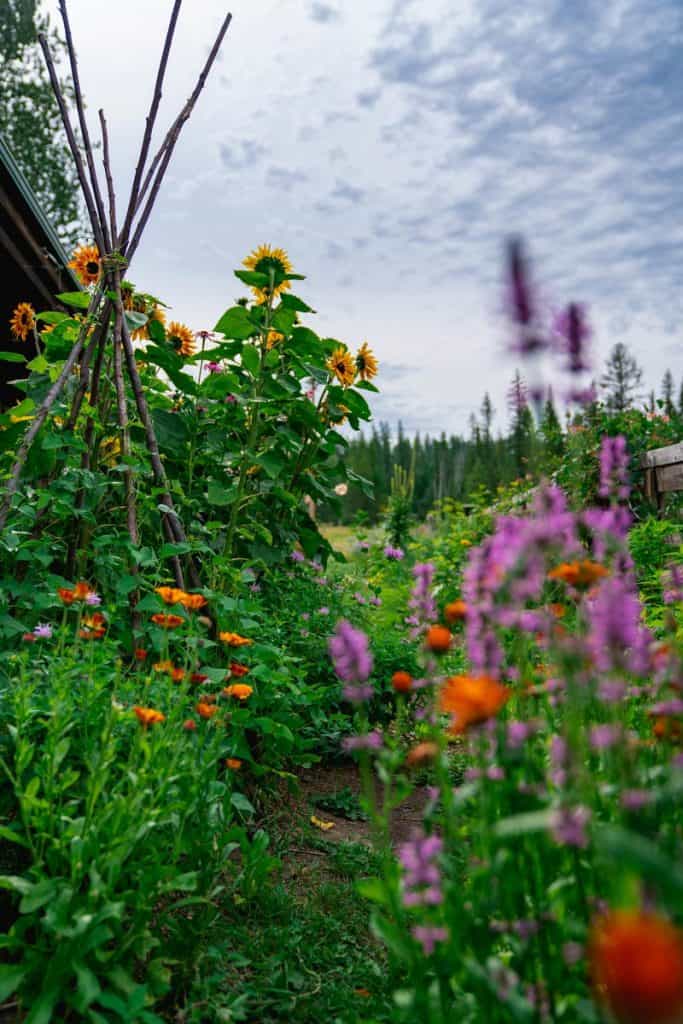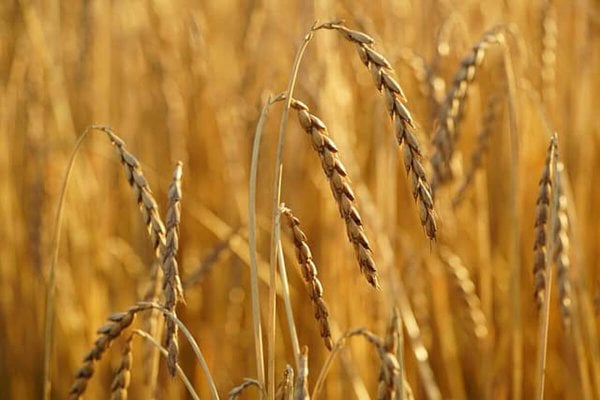My cottage garden (medicinal herb garden) is one of my favorite places to be and it’s so productive. Just four years ago this space was a lawn. We transformed it into a beautiful and lush cottage garden and now it’s bursting with medicine.

If you missed the video where we transformed our lawn into a productive garden, you’ll want to go watch designing an old-fashioned cottage garden here.
This cottage garden is a great example of how you don’t need much space to provide your family with an entire medicine cabinet of herbs. Getting started with medicinal herbs is probably much easier than you thought.
The beauty of these plants is that many of them are perennials, and they come back year after year. But the rest do such a great job of self-sowing that I don’t have to plant them either!
Join me on this tour with Doc Jones from HomeGrown Herbalist as he walks through my cottage garden and tells me what he thinks!
I’m very excited and a little nervous!
A lot of medicinal plants are so beautiful and make great landscaping. This is one of the reasons I love my cottage garden so much. It’s beautiful, attracts many pollinators, and I can stock my herbal medicine cabinet every year.

Medicinal Herbs In My Garden & Their Uses
Doc Jones shares that it doesn’t always matter what the delivery method of the herbs is, as long as we’re getting them into our system!
That means you can make a tincture, a salve, a poultice, and/or take them internally, and you’ll get their medicinal benefits. Sometimes combining these methods will even help speed up recovery.
- Yarrow – Yarrow is the best herb in the world for bleeding. It’s also a great respiratory herb. (Source)
- Lavender – Good for calming (Source), helping with insomnia and anxiety (Source), and killing off many bugs.
- Catnip – Great for calming (Source) and I use it for tummy aches (I make a glycerite to give my kids). Doc Jones says moms who drink catnip tea experience less colic in infants.
- Valerian – Great for insomnia and may ease pain (using a topical tincture). I like to take some when I’m feeling overwhelmed from the day, which calms me down. Doc Jones recommends using the valerian herb for panic attacks. (Source)
- Hops – Most people use hops for gastrointestinal issues. It’s very calming (Source), so it’s good for stomach aches. But it also has antibacterial properties (Source), so it’s good for infections in the gut. It won’t harm your good gut bacteria, which is nice. Doc Jones uses hops topically for pain by making a tincture and applying directly. (Source) Hops interact the same way the cannabinoid receptors do with your cells, so it can help alleviate the pain the same way as marijuana (but you don’t have to worry about THC). You can learn how to grow hops and make a calming hops tea here. You can use it as a tincture, topically in a salve, or even as a hops poultice.
- Calendula – Doc Jones says if he could only have five plants, calendula would be one of them. It’s a good antibiotic, it has some antiviral properties, and it’s anti-inflammatory. It accelerates healing like comfrey does, maybe not quite as fast. (Source) Calendula oil is an essential home remedy. I like how safe it is because it’s very family-friendly (unless you’re pregnant or nursing). And it is easy to grow calendula flowers in your garden and make a homemade burn salve.
- Elecampane Root – Some of elecampane’s many benefits are that it is an excellent expectorant and works so well for getting phlegm out of the lungs. (Source) It makes a great de-wormer (Source) because it breaks up mucous in your stomach and allows the worms to pass through. It’s also a great prebiotic and very good for gut health. It’s one of the best insoluble fibers around.
- Lemon Balm – It’s very good for insomnia and anxiety. (Source) Doc Jones recommends mixing it with St. John’s and using it for patients with bipolar disorder. Lemon Balm kills the herpes virus (shingles, cold sores), and you can use it both topically and internally.
- Monarda (Bergamot) – Also known as Bee Balm, this easy-care perennial is particularly good for fungal issues like yeast infections or athlete’s foot and works well with respiratory issues. (Source) We like to make a bag balm for the cows with a combination of monarda, cleavers and calendula.
- Hollyhocks (or Marshmallow) – Here at Riverbend, we use hollyhocks for anything we would marshmallow. Hollyhocks are great for reversing the early stages of gangrene. It’s also great to use for spider and snake bites.
- Sunflowers – I love using the sunflower petals to make a hair rinse. It adds nice shine to all the girls’ hair in the house.
- Echinacea (or Black Eyes Susan) – You can use both the root and the flower. It’s great for bacterial infections and colds. Doc Jones likes using echinacea root on rattlesnake and spider bites because it counteracts the venom, stops tissue destruction, and stimulates hyaluronic acid production.
It’s important to note that I am not a certified medical practitioner. This post is not intended to diagnose or treat but is for informational purposes only. Please contact your healthcare professional before introducing new herbal and natural remedies into your wellness routine.
Where to Find Doc Jones
For more information on Doc Jones or the School of Botanical Medicine, visit the links below.
- HomeGrown Herbalist on Facebook
- HomeGrown Herbalist on YouTube
- HomeGrown Herbalist website
- HomeGrown Herbalist School of Botanical Medicine

More Posts You May Enjoy
- Easy Home Remedy for Allergies (+ Hay Fever)
- Designing an Old Fashioned Cottage Garden
- 15 Medicinal Herbs To Grow, Harvest & How to Use Them
- How to Dry Fresh Herbs (Oven, Dehydrator, or Hanging)
- Homemade Arnica Salve
- Growing Chamomile
- Borage Plant Benefits and Cultivation Tips
- Using Herb Medicine Safely at Home


















